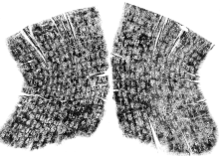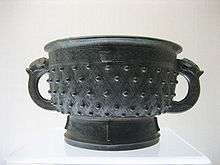Mao Gong ''ding''

The Mao Gong Ding is a bronze tripod/cauldron in Western Zhou. National Palace Museum in Taipei stores it. Height: 53.8 cm, wide: 47.9 cm,[1] weight: 34.7 kg.[2] This has an inscription of 497 characters arranged in 32 lines, the longest inscription among the ancient Chinese bronze inscriptions. Scholars think its date should be in King Xuan of Zhou reign.[3]
Inscription (abstract)
The King preached the morals after King Wen of Zhou and King Wu of Zhou to Yin (personal name) the Duke of Mao. Next, the King requested that the Duke should swear the solid allegiance to the King. The King appointed the Duke to take charge of all governing matters in the nation, including proclamations of statutes and codes, education of nobility youths, training guards, and administering domestic affairs. Decidedly the Duke was installed in a position above all people in the nation but one. In accordance with this great responsibility he was also greatly bestowed upon with: ritual jade, personal ornaments, court wear, adornment for his carriage, trappings for his horses, and so on.[4] At last the Duke said that he made this tripod for this award and the appointment from the King.[5]
History[6]
It was excavated in Shaanxi in the last years of Daoguang Emperor reign (1821-1850).[7] The famous collector Chen Jieqi (1813-1884) acquired it in 1852. He and his studio made precise rubbings of the inscriptions.[8] In Emperor Xuantong era (1909-1911) Duanfang (1861-1911) bought it from the Chen family. Ye Gongchuo (1881-1968) was the Minister of Transport. Then his friends bought and presented the tripod to him from the Tianjin Dao Sheng Bank who had it as mortgage. In Sino-Japanese war, the family of Ye Gongchuo sold it to Chen Yon Ren, a millionaire in Shanghai. In 1946 April, Chen Yon Ren donated the tripod to the Kuomintang Shanghai Government through a general in their army. In 1949, Chiang Kai-shek and the Kuomintang moved it to Taiwan.[9]
Notes
- ↑ Chinese Art Treasures, 1961
- ↑ The Mao Gong Din, 1986
- ↑ Chinese Art Treasures, 1961
- ↑ The Bell and Cauldron Inscriptions-A Feast of Chinese Characters: the Origin and Development - Mao Gong Ding
- ↑ Robert Eno
- ↑ mainly on The Mao Gong Ding, 1986
- ↑ Chinese Art Treasures, 1961
- ↑ "Rubbings of Inscriptions on Mao Gong Ding, the Duke Mao Tripod". 1852. Retrieved 27 February 2018. World Digital Library, Library of Congress
- ↑ The Mao Gong Ding, 1986
References
- Chinese Art Treasures, Exhibition Catalogue from the National Palace Museum, Taiwan in USA (1961-2), SKILA, Geneva, 1961
- Tan Danjiong (1906-1996), The Mao Gong Ding (Chinese Text), The National Palace Museum Monthly of Chinese Art volume4 no.4,127-136p 1986, Taipei, Taiwan
- The Bell and Cauldron Inscriptions-A Feast of Chinese Characters: the Origin and Development - Mao Gong Ding, National Palace Museum
- Robert Eno, Inscriptional Records of the Western Zou, 2012 74-76p, Indiana University SITE, Bloomington, USA
